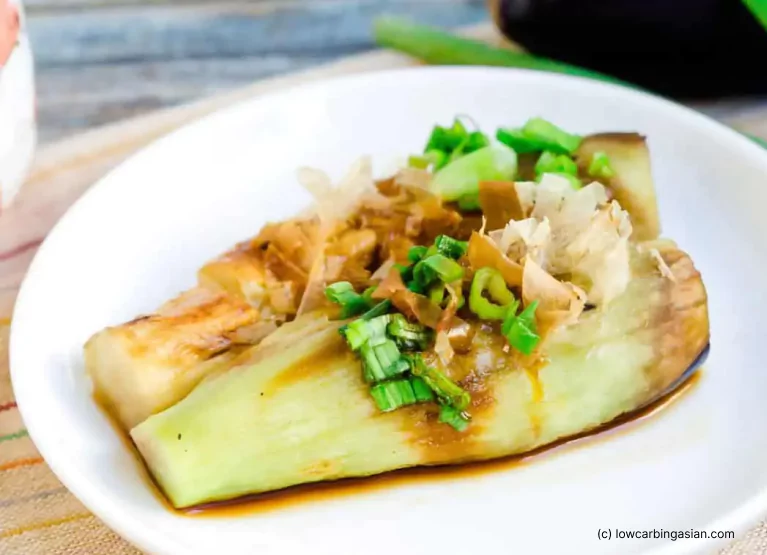Blood-Glucose Friendly Japanese Eggplant Recipes

Key Takeways
Eggplants are a type of nightshade and are full of a number of important vitamins and minerals. This vegetable, which is also known as an aubergine, is originally native to China and India.
The eggplant has been around for centuries, and is used in everything from Japanese to Italian cuisine. But one unique variety of this vegetable is the Japanese eggplant. While it shares a similar flavor profile to traditional eggplants, the Japanese eggplant is longer and more narrow, and differs slightly in taste.
If you’re looking for new ways to include this tasty and nutritious vegetable in your diet, look no further! In this article, we share six blood glucose-friendly recipes approved by Nutrisense dietitian Heather Davis, MS, RDN, LDN, plus her thoughts on why she loves each recipe.
Nutritional Content of Japanese Eggplant
Eggplants in general are considered to be extremely nutrient-dense foods. When it comes to nutritional value, there isn’t much difference between traditional eggplants and Japanese eggplants.
Each variety is high in fiber, and relatively low in calories, sodium, and carbohydrates. Here’s a breakdown of the nutrients found in eggplants:

Eggplants are also good sources of vitamins such as, vitamin A, vitamin C, vitamin E, and vitamin K. These vegetables also contain potassium, folate, manganese, folic acid, and thiamine.
A study conducted on mice also found that the antioxidant properties of enzymes found in eggplants reduced blood sugar levels in mice with diabetes. These findings suggest that it may be beneficial to include in your diet if you are managing your glucose level.
While this study is exciting, more research is still needed to determine how effective this connection is. Other research has found that eggplants may also have the following additional beneficial effects on your health.
- Can be anti-inflammatory
- May have anti-asthmatic properties
- May help lower blood pressure
- Can reduce blood clot formation
- Can help prevent buildup of harmful fats such as triglycerides
Seven Healthy Japanese Eggplant Recipes
Whether or not you’re a lover of eggplants, we’ll take you through seven of our favorite Japanese eggplant recipes that you’ll be sure to enjoy. Plus, expert Nutrisense dietitian Heather Davis, MS, RDN, LDN, will share why these recipes are healthy and how you can make them even better.
1) Heather Davis’s Spicy Eggplant Tofu Salad with Cashews
To start off, Heather shares one of her favorite homemade recipes that she regularly makes for dinner. This spicy eggplant tofu salad can be customized to your liking, and as mild or spicy as you prefer.

Ingredients
- 8 ounces extra firm tofu, drained and cut into cubes
- Dash of coconut oil or sesame oil
- 1 eggplant, sliced about a ½ inch thick
- ½ small head of cauliflower, chopped into small florets
- 4-6 cherry tomatoes, quartered
- ¾ cup cashews
- 1 tablespoon chili sauce or other hot sauce of choice
- Sea salt and freshly ground black pepper
- Romaine salad leaves or other lettuces of choice
Directions
- Place your tofu on a sheet pan and bake. In a separate dish, season your eggplant slices and bake them as well.
- While those are baking, heat up some oil in your skillet to cook the cauliflower until desired texture.
- When the eggplant is done, mix with the cauliflower for a few minutes to let the flavors blend.
- Place your lettuce into a bowl, top with eggplant and cauliflower mix, and tofu. Top with cashews and hot sauce as desired.
Why Heather Loves It
I like this recipe because it's a protein-rich plant-based option for those who are looking to include more plants in their diet while still opting for lower carb alternatives and rich flavors. You can also coat your tofu in almond flour before baking to make it extra crispy.
2) Roasted Japanese Eggplant with Crushed Tomato, Pecorino, and Thyme by Brett Anderson (from the New York Times)

This recipe by restaurant critic Brett Anderson takes a fine dining approach to cooking Japanese eggplant.
Ingredients
- 4 small Japanese eggplants
- 3 tablespoons extra-virgin olive oil, divided
- Sea salt
- Cracked black pepper
- 1 large, very ripe heirloom tomato
- 2 cloves garlic, crushed
- 4 sprigs of fresh thyme
- 2 ounces pecorino cheese, shaved or thinly sliced
Why Heather Loves It
I love the simplicity and flavors in this recipe! However, because it does run a little low in protein, you may want to think of this dish as more of a "veggie side" to your other main protein. Try pairing this dish as an appetizer before baked trout, steamed shrimp with lemon and pepper, or slow cooker chicken.
3) Baked Low FODMAP Eggplant Parmesan by For a Digestive Peace of Mind
This recipe is a great option for people who want to enjoy this vegetable but have specific dietary restrictions or are on an elimination diet.
Ingredients
- 1 large eggplant, cut in 1/2 inch thick slices, ends trimmed (about 12 slices)
- Salt
- 2 large eggs
- 1 cup plain gluten-free bread crumbs
- 1 tablespoon garlic infused oil
- 1 teaspoon dried basil
- 1 teaspoon dried oregano
- 1 1/2 cup diced plain canned tomatoes (drained of juice)
- 2 tablespoons Parmesan cheese
- 1 cup grated mozzarella cheese
Why Heather Loves It
This eggplant parmesan dish is a great option for anyone following a low FODMAP diet. I like to boost the protein content of this meal by including a simple side salad topped with proteins such as hard boiled eggs, chopped uncured ham or turkey, some sunflower seeds, and simple oil and vinegar dressing.
4) Japanese Roasted Eggplant Yakinisu by Low Carbing Asian

This recipe is a good alternative for those who are low carb (and can be easily modified to be more blood glucose friendly).
Ingredients
- 2 Whole Japanese Eggplants
- 2 tablespoons Bonito Flakes can sub with 1/8 tsp of hondashi
- 2 tablespoons Soy Sauce
- 1 tablespoon Japanese Sake
- 1 teaspoon sweetener (monk fruit erythritol blend, sugar or sweetener of choice)
- 1 tablespoon Bonito Flakes topping
- 1/2 Stalk Green Onions topping
Why Heather Loves It
This roasted eggplant plate is full of rich umami flavors and the Bonito flakes give it a boost of added protein. Adding a white fish such as hake or cod is a great way to up the protein content even more and help keep you satiated for longer.
5) Eggplant with Thai Basil and Chicken by Woks of Life
Along with using Japanese eggplant as the base, this recipe also incorporates protein. Protein, one of the three macronutrients, can be beneficial in balancing blood sugar.
Ingredients
- 8 ounces chicken breast, thinly sliced
- 2 tablespoons water
- 5 tablespoons vegetable oil, plus 1 teaspoon for marinating
- 1½ teaspoons light soy sauce
- 1 teaspoon cornstarch
- 2 Japanese or Chinese eggplants (about 12-16 ounces)
- 3 cloves garlic (sliced thinly)
- 3 scallions
- 1 bunch Thai basil or holy basil
- 1 tablespoon dry sherry cooking wine
- 2 teaspoons fish sauce
- ½ teaspoon sugar
- 1 teaspoon Thai thin soy sauce
- 1 teaspoon dark soy sauce
- ½ teaspoon sesame oil
- Ground white pepper
- ¼ cup chicken stock
Why Heather Loves It
This high-protein dish is full of flavor. For some substitutions for those who may have particular sensitivities or health concerns, I might suggest the following
- If you're concerned about the processed vegetable oils, you might consider replacing them with avocado oil or coconut oil.
- If you're wanting to go soy-free, you can substitute the soy sauce for coconut aminos.
- If you're wanting to avoid cornstarch, you can try arrowroot or even almond flour.
6) Easy Roasted Japanese Eggplant by MasterClass

This recipe by Michelin rated chef Niki Nakayama is a must-try for all lovers of gastronomy.
Ingredients
- 3 Japanese eggplants, sliced in half lengthwise
- 4 tablespoons olive oil
- 2 tablespoons soy sauce
- 1 ½ tablespoons white miso
- 1 tablespoon rice vinegar
- 1 teaspoon mirin
- 2 garlic cloves, grated
- 1 teaspoon crushed ginger
- Kosher salt and freshly ground black pepper
- 1 teaspoon toasted sesame oil, for garnish
- Toasted sesame seeds, for garnish
- 2 scallions, thinly sliced, for garnish
Why Heather Loves It
This is a simple and traditional recipe that's pretty straight forward to throw together. This would make a good side dish to other protein-rich foods on your plate!
The miso in this recipe does contribute a little bit of protein, but I would recommend opting for a little bit more. If you'd like a slightly non-traditional spin on your choice of vinegars and are feeling adventurous, you might even try replacing the rice vinegar for apple cider vinegar.
7) Ginger Pork Rolls with Japanese Eggplant by Just One Cookbook
This recipe is low in carbohydrates and high in protein. Think of it as a Japanese version of bacon roll-ups. If you have all the ingredients on hand, it’s quick and easy to throw together with just 15 minutes of prep time, for a total time of 30 minutes before it’s ready to enjoy.
Ingredients
- 2 Japanese eggplants
- ½ pound thinly sliced pork loin (1 package shabu shabu meat)
- 2 tablespoons cornstarch
- 1 knob fresh ginger
- 2 tablespoons soy sauce
- 2 tablespoons mirin
- 1 tablespoon sake (or water)
- 1 teaspoon sugar
- 1 tablespoon roasted sesame oil
- ½ teaspoon miso
- 4 shiso leaves
Why Heather Loves It
These pork rolls make for a great appetizer or can even be eaten as your main dish. To make them more glucose-friendly, swap out the cornstarch for almond flour and omit the sugar.
Find the right Nutrisense programto turn insight into progress.
Go Beyond Glucose Data with Nutrisense
Your glucose can significantly impact how your body feels and functions. That’s why stable levels are an important factor in supporting overall wellbeing. But viewing glucose isn't enough. Nutrisense, you’ll be able to learn how to use your body's data to make informed lifestyle choices that support healthy living.
One-to-one coaching
Sign up to access insurance-covered video calls to work with a glucose expert: a personal registered dietitian or certified nutritionist who will help tailor your lifestyle and diet to your goals.
Monitor and measure what matters
With the Nutrisense CGM Program, you can monitor your glucose with health tech like glucose biosensors and continuous glucose monitor (CGM)s, and analyze the trends over time with the Nutrisense App. This will help you make the most informed choices about the foods you consume and their impact on your health.
Find your best fit
Ready to take the first step? Start with our quiz to find the right Nutrisense program to help you take control.

Jordyn has a bachelor’s degree in biology, a graduate degree in Human Nutrition and completed a dietetic internship at the Memphis VA. She's a dietitian at Nutrisense, and has experience working as a clinical dietitian at a VA medical center specializing in oncology and at the Mayo Clinic, working with a wide range of patients ranging from neonates in the NICU to adult ICU.




